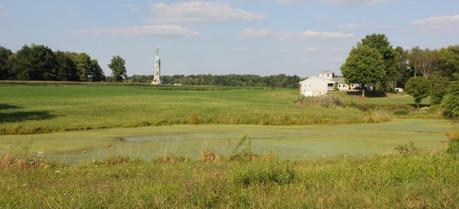 Scientists suggest ways to use less fresh groundwater for hydraulic fracturing. (Credit: Flickr @ WCN 24/7 https://www.flickr.com/photos/wcn247/)
Scientists suggest ways to use less fresh groundwater for hydraulic fracturing. (Credit: Flickr @ WCN 24/7 https://www.flickr.com/photos/wcn247/)According to a new report released by Texas A&M University, oil and gas exploration operations can switch from fresh groundwater of brackish groundwater.
Oil and gas exploration operations can and must operate under environmentally sound practices and according to a research study at Texas A&M University, hydraulic fracturing in the Eagle Ford Shale in South Texas can lessen its environmental impact by switching from fresh groundwater to abundant supplies of brackish groundwater.
SEE ALSO: Hydrofracking Fluids Could Pollute Groundwater Indirectly

James Griffin
Graduate students at the Bush School of Government and Public Service, under the leadership of James M. Griffin, professor and Bob Bullock Chair in Public Policy and Finance, studied water consumption from oil and gas exploration in the Eagle Ford Shale for Commissioner Christi Craddick of the Texas Railroad Commission (RRC) and published their findings in the report “Water Use In the Eagle Ford Shale: An Economic and Policy Analysis of Water Supply and Demand.”
The Eagle Ford Shale is a massive geologic formation spanning 30 Texas counties from Brazos County in the northeast to Webb County in the southwest. More than 200 operators are tapping into previously inaccessible oil and gas reserves in the Eagle Ford Shale with the use of hydraulic fracturing (HF) and horizontal drilling. “Even in its incipiency, the economic benefits to the region and the state are enormous,” Griffin notes.
As it stands, approximately 90% of the water used in HF in the area is from fresh groundwater aquifers. The crux of the researchers’ recommendation is to incentivize the substitution of brackish groundwater for fresh groundwater at a low cost to the state and operators in the region. “Brackish groundwater, which has high salinity but is still useable for hydraulic fracturing, is an obvious help to conserving fresh groundwater,” says Griffin. “But the problem of adequate future fresh groundwater supplies is much larger than its use by the industry. Future research is focused on other regulatory steps.”
The researchers studied groundwater consumption within the Eagle Ford counties over a span of four years, looking not only at oil and gas exploration water consumption, but also at municipal consumption, irrigation and other categories. “This analysis showed that fresh groundwater is being consumed at about 2.5 times the groundwater recharge rates,” according to the report. Irrigation is using more water than all the other categories combined, the researchers find, so the water problem reaches well beyond the use of fresh groundwater for oil and gas exploration.
But they found a difference can be made in conserving fresh groundwater in the shale, not through technology, but rather by designing better public policies that incentivize HF operators to substitute brackish groundwater for fresh groundwater.
“By using brackish water for HF, companies would no longer compete with farmers and municipalities for increasingly scarce fresh groundwater supplies,” explains Griffin, an expert in micro-economics and energy policy.
“Operators would receive a ‘Green Star’ recognition from the RRC and possibly the TCEQ (Texas Commission on Environmental Quality) if they take the pledge to avoid using fresh groundwater and agree to be compliant with all other environmental regulations,” he says. “This program would consist of a bronze, silver and gold tier, depending on the amount of fresh groundwater used.”
Another incentive recommended by the research team involves a severable tax reduction for wells drilled by operators who have qualified for at least bronze-level status in the Green Star program. “Together, these two components provide operators a financial and social incentive to conserve fresh groundwater,” Griffin notes.

If oil and gas companies switch to brackish water, it would leave more fresh groundwater for farmers and municipalities, say the researchers. (Credit: Flickr @ AgriLife Today https://www.flickr.com/photos/agrilifetoday/)
The study also recommends mandatory reporting of all groundwater uses by all classes of water users, bringing more transparency.
And, say the researchers, groundwater property rights should be defined on a per-acre ownership basis, which would attach to the surface owner’s real property. “This way, the owners of the water rights could sell their water and the market would adjust the price of water to an economically efficient level. This would remove the incentive to use all you can today, leaving more water for the future at a lower future price,” according to the report.
Following the plan suggested by the research team would help to improve the public perception of not only individual companies, but the industry as a whole, says Griffin. “And an additional benefit to the RRC is that this program would evidence the commission’s forward-looking agenda and demonstrate its proactive efforts to solve both a quantitative and qualitative environmental problem without the help of the Environmental Protection Agency,” he asserts.
The Eagle Ford Shale has provided the state budget with a huge windfall, says Griffin, and using a small portion of this windfall to incentivize shifting away from using fresh groundwater is a wise long-term investment for Texas. And, he adds, “It would demonstrate Texas’ ability to solve its own problems.”
Another Texas A&M entity, the Texas A&M Water Conservation and Technology Center, is also addressing water concerns in the Eagle Ford Shale. A spokesperson for the center has indicated there is a lack of communication between communities in the region and the companies that are conducting oil and gas exploration operations in the area. The center’s proposal is being considered by the Alamo Area Council of Governments.

